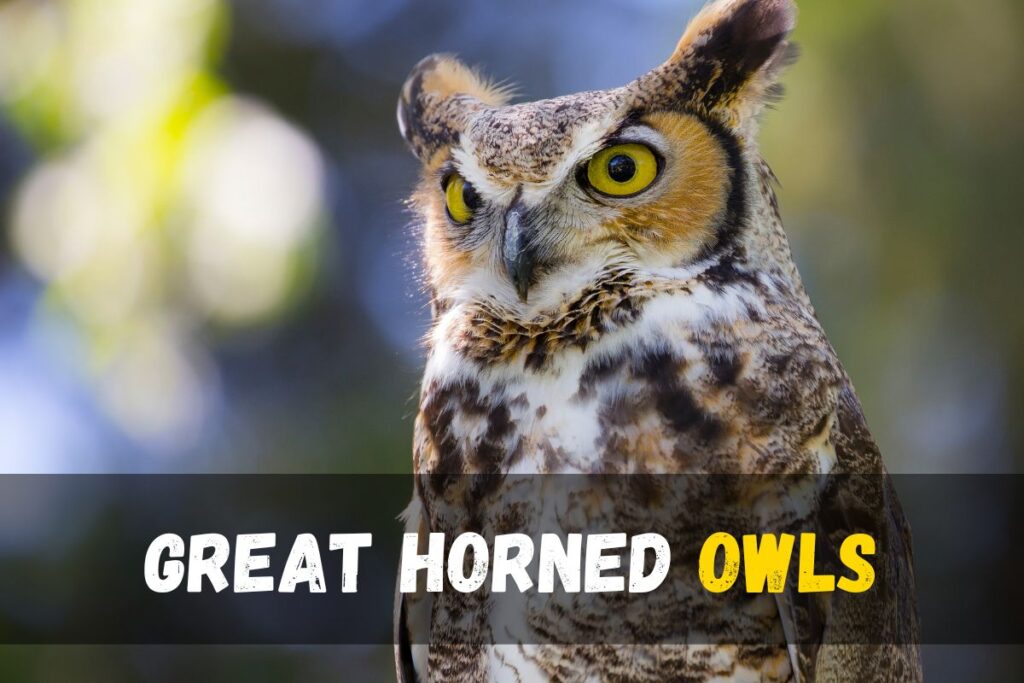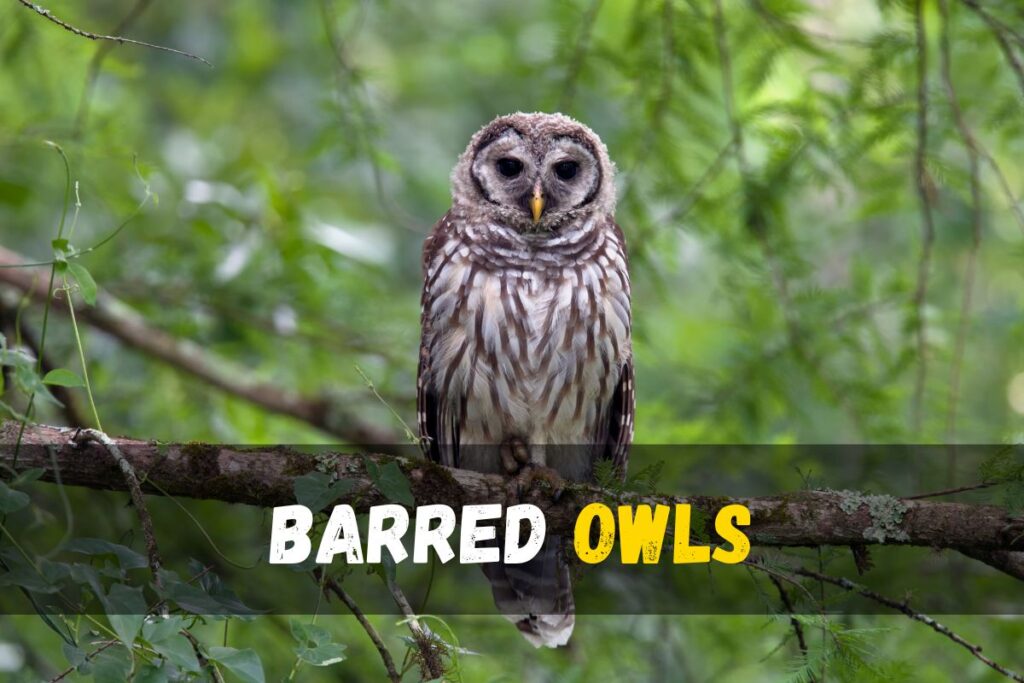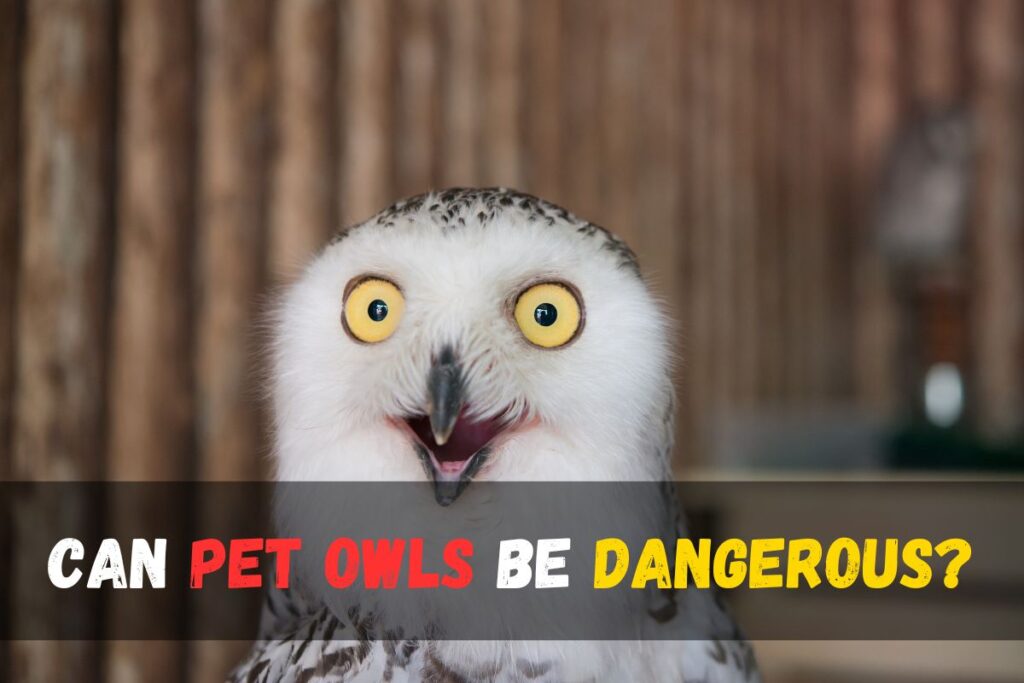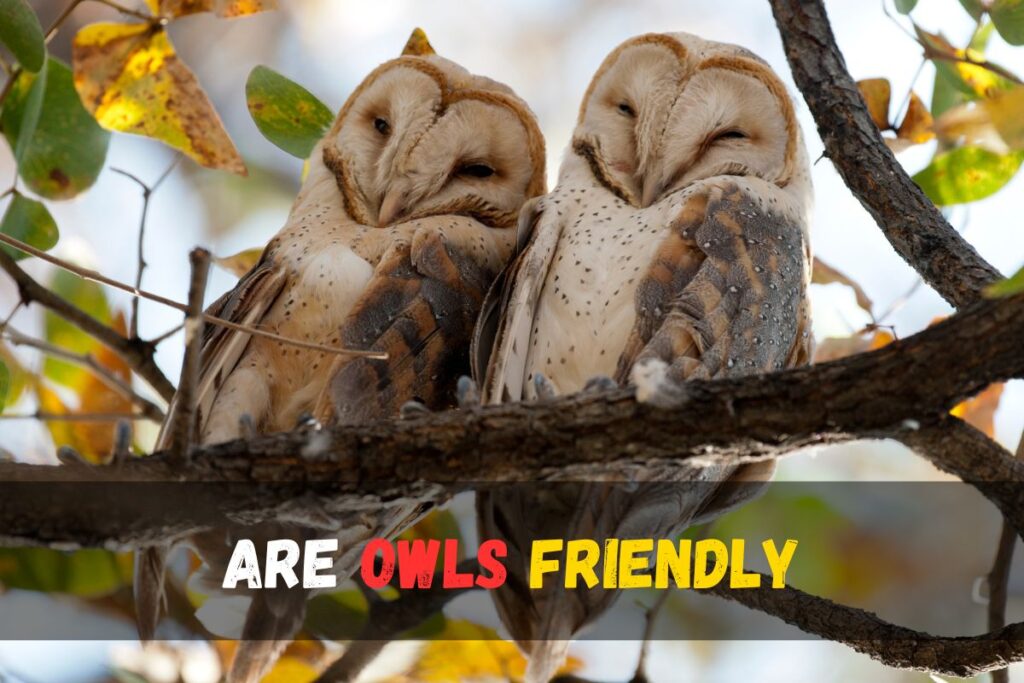Are owls dangerous?
Many have pondered the question: are owls dangerous or friendly? Can these seemingly gentle creatures truly pose a significant threat to humans or other living beings? In this exploration of the fascinating world of owls, we shall unravel the mysteries surrounding these enigmatic birds and shed light on their true potential for harm and the intriguing intricacies of their existence.
When considering the potential danger owls pose, it’s vital to recognize that their behavior is primarily instinctive. For instance, larger species like the great horned owl or the barred owl, with their impressive wingspan and powerful feet armed with sharp talons, can seriously injure smaller animals or birds, their primary prey. These sharp talons, designed for gripping and killing, can exert considerable pressure, capable of puncturing bones, skin, and soft tissues.
Regarding interactions with humans, instances of owl attacks on people are notably rare. Despite their capability to harm, these predatory birds are generally uninterested in humans and pose minimal risk if left undisturbed. Nevertheless, there have been documented cases of lacerations or puncture wounds when individuals inadvertently encroach upon an owl’s space or disrupt their nesting sites.
Owls, like many wild birds, are protective of their young and hunting grounds. The fearlessness they exhibit in defending their territory, chicks, and mates is not necessarily an act of aggression, but rather an instinctive response to perceived threats. Their keen hunting abilities and exceptional vision make them formidable predators in the wild, but their reputation for being dangerous to humans is often overstated.
Do owls attack humans?
What Owl Species Are Most Likely to Attack Humans?
Owls are generally not known to be aggressive towards humans, and attacks on humans by owls are rare. However, there have been a few reported cases of owl attacks, and these incidents are typically associated with a few specific owl species. The most common owl species involved in such incidents include:
Great Horned Owls
Great Horned Owls, revered for their majestic appearance and large size, are generally not known for targeting humans. However, they are territorial and fiercely protective of their nests and young. This protective behavior can lead to incidents where they swoop down and strike humans who inadvertently approach their nesting sites. These powerful birds of prey possess strong talons and sharp beaks, making any physical encounter potentially dangerous. Understanding the nesting habits and locations of Great Horned Owls can help reduce the risk of such encounters. It’s important to remember that these owls do not intentionally attack humans but are acting out of instinct to safeguard their offspring

Barred Owls
Barred Owls, while not typically aggressive, can exhibit more assertive behavior when it comes to protecting their nests. They are known to dive-bomb intruders that venture too close to their nesting sites, and this can include humans. While their intentions are not to harm, these encounters can be startling and even cause minor injuries. Being aware of the presence of Barred Owls and their nesting areas is essential during breeding seasons. These encounters serve as a reminder that these fascinating birds, like all wildlife, deserve our respect and a safe distance to carry out their natural behaviors without feeling threatened by human presence.

Snowy Owls
Snowy owls could potentially be more prone to defensive attacks, particularly if humans inadvertently encroach upon their nesting sites or disturb their territories. They known for their large size and territorial nature might pose a higher risk of defensive behavior if humans get too close to their nesting areas in their natural habitats, such as in extreme northern parts of the United States, like Maine, where these majestic birds are commonly found.

What to do in case of an owl attack
If an owl attacks you, it’s important to remember that owls don’t typically view humans as prey. However, in rare cases, if you find yourself in a situation where an owl is swooping down towards you, here are some things you can do to protect yourself:
Cover Your Neck and Head
If an owl attacks you, it’s essential to protect your neck and head, as these are the areas where the owl is most likely to inflict the most damage. Owls are silent fliers and often take their prey by surprise, so it’s crucial to be prepared. If you see an owl flying towards you, cover your neck and head with a solid object like a handbag, umbrella, or an article of clothing such as a hat or a coat if you have one. An umbrella can be particularly effective because owls tend to attack the highest part of your body. If you don’t have these objects, consider using your arms and hands to shield yourself from the owl’s attack. Additionally, be aware that owls may focus on your neck and head if they perceive you as prey, so taking these precautions is essential to avoid harm.
Stay Calm and Stand Your Ground:
Owls typically do not attack humans unless they feel threatened or cornered. If an owl is swooping or flying around you, it’s essential to remain calm. Avoid making sudden movements or loud noises that could agitate the owl further. Standing your ground and not panicking is often enough to deter the owl from approaching.
Don’t kill the Owl
If you find yourself in a situation where an owl attacks you, it’s crucial to prioritize your safety. Avoid engaging in a confrontation or attempting to fight the owl. Your best chance of surviving such an encounter is to calmly and slowly retreat or run away from the owl. However, if you end up in a physical struggle with the owl, refrain from causing harm or attempting to kill it.
It’s important to understand that harming an owl, including its babies or nest, is a punishable offense in several countries such as the UK and the U.S., where fines or even imprisonment can be imposed for such actions. Therefore, the recommended action when faced with an owl attack is to focus on self-preservation and avoid harming the owl. Retreat calmly and seek safety without causing harm to the bird.
Back Away Slowly
Slowly back away from the owl while keeping it in your line of sight. The owl may have attacked because it felt cornered or threatened, so by retreating, you’re allowing it to escape the situation without feeling the need to defend itself.
Avoid Eye Contact
While maintaining eye contact can help deter the owl, direct and prolonged eye contact might be perceived as a challenge. You want to strike a balance between watching the owl and not appearing confrontational. If the owl is focused on you, turning your head slightly to the side can reduce the intensity of your gaze.
Do Not Scream or Yell
Loud noises and sudden movements can further agitate the owl. Try to remain quiet and composed. Shouting or screaming may make the owl more defensive or agitated.
How are owls dangerous?
Owls are dangerous due to their sharp talons, particularly the great horned owl, which is the largest owl in the United States and possesses the largest talons. These talons, around 8 inches in span, are similar in size to a human hand and can cause significant harm. Owls have four toes, with three facing forward and one in the back, providing them with the perfect claw for hunting. When looking up and witnessing their clawed talons heading toward you, it’s a rare but potentially dangerous encounter. The force exerted by the talons of the Great Horned Owl is between 300-500 pounds per square inch, which is comparable to the strong bite of a dog, making it a formidable and potentially harmful predator in its own right.

Can pet owls be dangerous?
Yes, pet owls can potentially be dangerous. While owls are fascinating creatures, they are not domesticated animals and have instincts that may lead to aggressive behavior. Owls have powerful talons and beaks designed for hunting and defense in the wild. If they feel threatened or stressed, they might attack by biting or using their sharp talons, causing injury.

Can owls be dangerous to pets?
Yes, owls can pose a danger to small pets such as small dogs, cats, rabbits, and other tiny animals. While most owls do not actively hunt domestic pets, smaller pets left unattended outside, especially during the evening or nighttime, could be seen as potential prey by certain owl species.
Owls are opportunistic hunters and might perceive smaller animals as potential food. Larger owl species, like great horned owls, for instance, are capable of taking animals as large as a housecat. To protect pets from potential owl attacks, it’s advisable to keep them indoors or supervised when outside, especially during dawn or dusk when owls are more active.
Creating safe enclosures, ensuring pets are indoors during nighttime, and supervising outdoor activities can help minimize the risk of encounters between owls and pets.
Do owls carry rabies?
No, owls do not carry rabies. Rabies is a viral disease that primarily affects mammals, and owls are birds. Since the rabies virus does not infect birds, owls cannot transmit rabies to humans or other animals. According to the CDC, a certain number of dogs and cats are reported to be rabid each year, but there is no mention of owls being carriers of rabies. Owls have their own set of diseases and health concerns, but rabies is not one of them. It’s important to remember that while owls are not rabies carriers, they can still carry other diseases or parasites, but these are typically not zoonotic, meaning they are not easily transmitted to humans.
How do owls protect themselves?
Owls protect themselves using their unique physical attributes and behaviors. They have sharp beaks and blade-like curved talons that allow them to defend against predators and perceived threats. These talons can grip, pierce, scratch, and even rip through flesh in a matter of seconds, making them formidable in self-defense. When owls feel threatened, they employ a strategy of sudden and silent swooping, taking potential intruders by surprise. This swift and stealthy approach, combined with their powerful talons, enables owls to effectively protect themselves by launching a counterattack against those who pose a danger.
When do owls get aggressive?
Owls tend to get aggressive when they perceive a threat to their mates, their young, or their territories. This protective behavior is not limited by the size of the intruder, and they may attack without hesitation. Breeding or broody owls, in particular, can be especially aggressive and may attack without warning. Additionally, recently matured male owls with elevated testosterone levels may exhibit feisty behavior as they strive to establish their position in the natural pecking order of their woodland habitats. So, owls can become aggressive when their loved ones or territories are at risk, and during their maturation phase when they are vying for dominance in their environment.

Are owls aggressive to other birds?
Owls are not typically aggressive to other birds during daylight hours. In fact, in what may be considered a reversal of roles, owls resting on a perch during the day may frequently be mobbed or dive-bombed by smaller groups of birds, but they do not react or respond to this harassment in any way. Instead, they may eventually fly off to escape the unwanted attention. Owls are largely nocturnal, so they tend not to cross paths with many other birds during their waking hours. While they do occasionally hunt and prey on other birds, this behavior is largely opportunistic and not a major component of their diet.
How Can You determine if an owl poses a threat?
Owls, in general, are not inherently dangerous to humans. However, they are wild animals, and if they feel threatened or provoked, they might exhibit defensive behaviors. To determine if an owl might be potentially dangerous or feeling threatened, it’s essential to observe their body language and consider the context of the situation. Look for signs such as an aggressive posture, hissing or clicking sounds, and physical signs of distress, including pecking or talon use. If an owl is protecting its nest, it may become defensive. Additionally, if an owl repeatedly swoops or vocalizes loudly around you, it may indicate that you’re too close to its territory. To avoid potential conflicts with owls, it’s crucial to maintain a safe distance, respect their space, and refrain from approaching nesting areas, especially during the breeding season. Owls generally try to avoid confrontations with humans and will often retreat if given the opportunity. Respecting their space and observing them from a distance is the best way to prevent any potential conflicts. If you’re uncertain or concerned about an owl’s behavior, it’s advisable to contact a local wildlife expert or rehabilitation center for guidance.
Are owls friendly
Owls, by nature, aren’t inclined to be friendly towards humans. They tend to exhibit signs of discomfort and even aggression when approached or handled. This behavior is inherent in both wild and captive owls alike. Even when hand-raised, they may still shy away from extensive human contact. This reluctance stems from their instinct to avoid human interaction, which is typical among non-domesticated animals. Owls, being nocturnal creatures, prefer to steer clear of human activities and habitats, minimizing potential threats to their safety. Consequently, encounters with wild owls are rare for most people.

Additionally, it’s important to note that keeping wild owls as pets is illegal in the US except for special circumstances such as licensed rehabilitation centers. In the UK, while legal, ownership of wild owls often results in short-lived arrangements due to the challenges of meeting their needs. Prospective owl owners may have unrealistic expectations of forming close bonds with these creatures, often picturing them as cuddly companions. However, the reality seldom matches these expectations, leading to disappointment when the anticipated friendship fails to materialize.
Reasons why owls are unfriendly.
There are several reasons why owls are not friendly with humans. Below we are going to discuss it in detail
Solitary Nature
Owls possess a distinct inclination towards solitude, which significantly shapes their demeanor towards others, including humans. Unlike many other avian counterparts, owls exhibit a pronounced tendency towards solitary living. This solitary nature is deeply ingrained in their behavior and is reflected in their avoidance of social interactions. Owls, unlike flock birds, don’t seek companionship or engage in friendly or affectionate behavior with others of their kind or even with other animals.
This solitary disposition finds its roots in the evolutionary adaptations of owls. They have evolved as proficient hunters and adept roosters, preferring to pursue their activities alone rather than in the company of others. This preference for solitary living not only dictates their interactions with their species but also extends to their interactions with humans. Owls, being solitary creatures by nature, are generally less inclined to socialize with humans.
Furthermore, the solitary nature of owls can also be attributed to their biological makeup. Unlike some other bird species that thrive in communal living, owls are wired to function autonomously. This innate inclination towards independence makes them less likely to seek out or engage in social interactions with either their kind or humans
Predatory Instincts
Owls, with their keen predatory instincts and finely tuned hunting skills, have evolved as formidable predators in the wild. These instincts, crucial for their survival, also play a significant role in shaping their behavior towards humans. Rather than exhibiting friendly behavior, owls often perceive humans as potential threats or predators themselves. This perception triggers responses of aggression or fear, deterring them from displaying the affable demeanor that humans might expect. Thus, the intricate interplay between their predatory nature and survival instincts explains why owls are not inherently friendly towards humans.
Territoriality
Owls, renowned for their territorial nature, demonstrate a remarkable instinct to defend their space, particularly when it involves safeguarding their offspring. This innate behavior often leads them to perceive any intrusion as a potential threat, prompting swift and aggressive actions. Their territoriality is a fundamental aspect of their survival strategy, ensuring the protection of their nesting grounds and the safety of their young. Consequently, while these magnificent creatures may not exhibit friendliness in conventional terms, their instinctual drive to protect their territory and progeny underscores the importance of this behavior in the intricate web of ecological dynamics.
Fear
Owls exhibit a natural wariness towards anything they perceive as a potential threat or risk, a trait deeply ingrained in their instincts. Humans, with our imposing stature and propensity for loudness, often trigger this defensive response in owls, causing them to avoid human presence whenever feasible. This fear is accentuated by their adeptness at camouflage and their preference for a nocturnal lifestyle, which renders them elusive and difficult to spot. Consequently, owls tend to maintain a shy demeanor, preferring to stay hidden rather than risk encountering perceived dangers. Thus, the combination of their instinctive responses, nocturnal habits, and camouflage abilities contributes to the notion that owls are not inherently friendly creatures towards humans.
Do Owls Like Humans?
Considering the relationship between owls and humans, it’s important to understand that owls, being wild animals, don’t exhibit preferences in the same manner as humans. Unlike humans, they don’t form likes or dislikes towards individuals. However, when owls are exposed to humans from a young age, they may become accustomed to human presence and may not perceive humans as a threat. While some owls may seem comfortable around humans, it’s crucial to recognize that this comfort isn’t natural for them, and becoming too familiar with humans can pose risks for both the owl and the human involved. Interacting with owls or any wild creature carries inherent dangers, as wild animals can display aggression due to their unpredictable nature.
Do Owls Attack Humans?
FAQ’S
Has an owl ever killed a human?
While there is one widely reported case of an owl being embroiled in a homicide case, there is no conclusive evidence to prove that an owl, specifically a barred owl, was responsible for the suspicious death of Kathleen Peterson in 2001. Some believe that her horrific head and scalp injuries may have been inflicted during a frenzied attack by a barred owl, and feathers found at the scene may support this theory. Barred owls have been involved in a series of attacks on joggers and hikers across the southern United States, resulting in many serious head injuries and scalp lacerations. However, this single case remains highly debated, and there is no definitive proof that an owl has ever killed a human.
Do owls attack cats?
Owls generally target smaller, slower-moving mammals like young mice or rats. While it’s not common for owls to attack cats, it’s not unheard of. Larger owl species like the eagle owl have the hunting capabilities to potentially go after a pet feline. Smaller owl species, however, may not attempt to attack a cat unless the cat is actively intruding on their territory or straying near their nest site. So, while it’s not a regular occurrence, there are circumstances where owls might attack cats.
What owl species are the most aggressive?
Among owl species, the great horned owl (Bubo virginianus) is often considered one of the most aggressive and formidable. Great horned owls are large, powerful birds known for their territorial and assertive nature. They are apex predators in their ecosystems and can display aggression towards other birds, including other owl species, hawks, and even larger birds of prey.
Their aggression primarily comes into play during the breeding season when they become highly protective of their nests and young. Great horned owls are known to take over the nests of other raptors, such as red-tailed hawks, and can be quite confrontational with any perceived threats to their territory.
While great horned owls are recognized for their aggressiveness, it’s important to note that aggression levels can vary among individual owls, and not all great horned owls will exhibit the same degree of aggression. Other factors, such as habitat and food availability, can also influence their behavior.
Does an owl pose a threat to humans exclusively during the nighttime?
Owls, whether it’s day or night, are generally not prone to attacking humans. They are not typically aggressive towards people and prefer to avoid human contact. While there are rare situations where owls might display defensive behavior if they feel threatened or perceive a person as a potential threat or prey, such instances are uncommon. In most cases, owls will choose flight over confrontation when encountering humans.
Is it OK to touch an owl?
No, it is not advisable to touch or attempt to handle an owl. Owls are wild birds and can become stressed or agitated if they are touched or handled by humans. Additionally, owls have sharp talons and beaks that they can use to defend themselves if they feel threatened. Handling an owl without the necessary knowledge and training can result in injury to both the owl and the person trying to touch it.
What does Islam say about an owl?
In Islam, owls are not considered to be a bad omen, contrary to past beliefs and superstitions. Islamic teachings do not associate owls with harm or negative omens. This perspective is in line with the broader belief system and cultural interpretation within Islam, which emphasizes faith and theology over historical misunderstandings. Therefore, there is no prohibition against owls living around one’s house in Islamic teachings.
Is Owl good luck?
In mythology, the perception of whether an owl is considered good luck or bad luck depends on the circumstances. Some believe that seeing an owl can be a sign of good luck, while others view it as a potential omen of misfortune. It’s also thought that encountering an owl during the day is associated with bad luck and may be seen as a forewarning of a tragedy. Therefore, the belief in the luck associated with owls is not consistent, and it varies based on cultural superstitions and individual interpretations.


